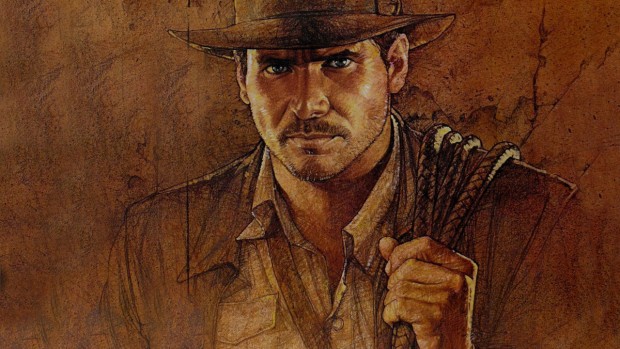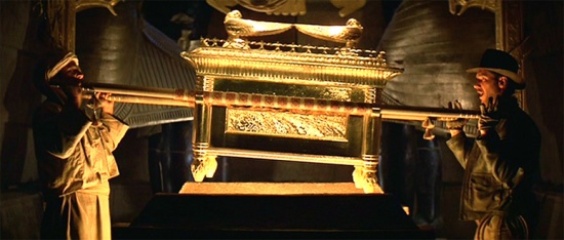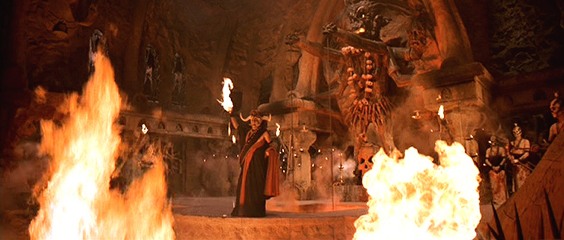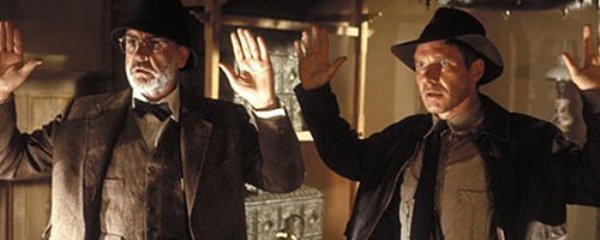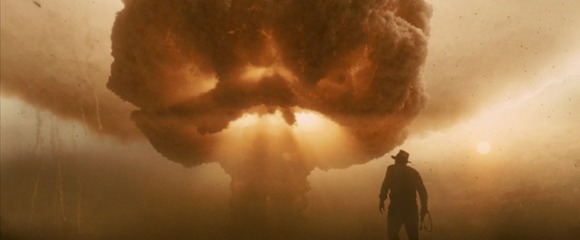New ideas come about and change the course of cinema on occasion, but what usually drives the engines of the film industry is their reliance on sturdy film franchises. You’ll find within a given year that most of the movies hitting the market are either sequels or a sequel to a sequel. Now while many films don’t necessarily lend themselves well to a becoming a franchise, there are some that have kicked off a series that continues on long after their initial start. For good or bad, we see film studios invest a lot of money into building up a franchise, mainly because they are great at generating revenue from a devoted fanbase and are easy to replicate with each new installment. Some franchises have become so popular that they’ve been more defined by their whole than by just any individual film. The most memorable franchises usually revolve around one of two things; an iconic character whose exploits become grander in each new series installment, or a richly detailed world that builds its cast and geography the longer that its story can go on. These franchises have become such a major part of the legacies of Hollywood studios that I want to focus on them individually in a new series of articles. In these posts, I’ll look at each entry of a franchise and examine how they work individually and as part of the whole of their series; as well as the histories and the interesting aspects of each film.
Appropriately enough, the franchise that I plan to look at first is also one of my absolute favorites: The Indiana Jones Series. Following the adventures of Dr. Henry Jones Jr. (aka Indiana Jones), the films in this franchise have become some of the most beloved in the last half-century. The brain child of Star Wars creator George Lucas, Indiana Jones was meant to be a throwback to the action serials of the 1930’s and 40’s; a long forgotten genre in cinema. Star Wars was a similar throwback to the sci-fi serials of the 50’s, so George Lucas naturally saw the potential of the character as a central figure to build a franchise around this idea. To help him realize it, George Lucas approached his colleague and friend Steven Spielberg to direct the introductory film, Raiders of the Lost Ark (1981). Spielberg, coming off the disastrous premiere of his WWII comedy 1941 (1979), gladly accepted the project, given that he had the same kind of enthusiasm for old serials that Lucas did. The casting of Harrison Ford as Dr. Jones seems like a no-brainer today, but would you believe that Harrison Ford stepped into the role only after Magnum P.I.‘s Tom Selleck turned it down. This collaborative team up is both exceptional and unique, mainly because it has never changed over 30 years and 4 films. Only the screenwriters and the supporting cast changes. Mr. Spielberg directed every entry, with George Lucas producing and Harrison Ford being the one and only Indiana Jones. Knowing these details behind the films, lets now look at each one individually.
RAIDERS OF THE LOST ARK (1981)
The introductory film of the franchise is also the one that people regard as the best. Everything that makes an Indiana Jones movie what it is can be seen laid out in this film. The swagger and resourcefulness of the main character; the mystery surrounding the central artifact; the international conspiracies and villains that Indiana Jones must battle against; and most importantly, the franchise’s sense of fun. The story finds Indiana Jones on a quest to seek out the biblical Ark of the Covenant before a group of Nazis can get to it and unleash the God-given power it holds. Making matters worse, Dr. Jones arch-rival, French archaeologist Belloq (Paul Freeman) is aiding the Nazis in their search. With the help of an old flame, Marion Ravenwood (Karen Allen), and an Egyptian handyman named Sallah (John Rhys-Davies), Indiana Jones finds himself in a globe-trotting adventure to keep the Ark safe from evil forces. It’s a straight-forward adventure that keeps things simple, and that’s the film’s greatest strength. It’s an escapist adventure that relies upon the strength of it’s characters and the excitement in it’s action scenes. It’s that timelessness that makes the film resonate 30 years after it was made.
There are so many iconic moments in this film; the most famous probably being the scene where Indy is chased by a giant boulder. Spielberg’s direction plays a large part in making the film so memorable, because few other directors can make extra-ordinary moments like that one feel so believable; he’s also very good at creating iconic moments. The writing, done by Lucas and Phillip Kaufman, is also well balanced; earnest when it needs to be and tougne-in-cheek silly at just the right times, much like the serials it’s trying to emulate. It’s no surprise that Harrison Ford owns the role he plays. From the first moment he steps into frame to the final scene, he is Indiana Jones. He manages to keep the character intimidating and rugged all throughout the story, even in the lighter moments; I especially like the way he freaks out when he finds a snake in his lap (“I HATE SNAKES. I HATE THEM”). The rest of the cast is also just as strong. Karen Allen makes Marion Ravenwood one of the strongest heroines in any action film. She is no damsel in distress (though she does need saving in some instances) and is Indiana’s equal in almost every way. Paul Freeman’s Belloq, while not too intimidating, is still an effective villain for this film and his ability to outsmart Indiana Jones does provide the movie with some extra tension. Also, there is a memorable turn by actor Ronald Lacey as the creepy Nazi agent Toht; a character that has little to do with the overall plot, but is a welcome addition nonetheless.
Raiders of the Lost Ark is a perfect example of how to kick start a franchise. It stands on it’s own as a great adventure, but it also leaves room to continue the adventures of Indiana Jones beyond it’s running time. Raiders is briskly paced and very satisfying, which helps to give the audience an appetite for more. It was a huge success upon it’s initial release, grossing $212 million (which is over $600 million in today’s money), and it even received an Oscar nomination for Best Picture. I’m sure that Lucas and Spielberg had a sequel in mind long before they had the success of the first film, but it would prove to be a shakier road than they realized.
INDIANA JONES AND THE TEMPLE OF DOOM (1984)
Three years after Raiders, Spielberg and Lucas released what is definitely the darkest entry in the Indiana Jones series. Indiana Jones and the Temple of Doom first finds Dr. Jones escaping a Shanghai crime lord, accompanied by a pampered night-club singer named Willie (future Mrs. Spielberg, Kate Capshaw) and an orphaned Chinese pick-pocket named Short Round (Ke Huy-Quan). After escaping a sabotaged plane in the Himalayan mountains, they find themselves in an impoverished Indian village, which has had a mystical stone stolen from them, along with many of their children. Dr. Jones agrees to help the village find the stone and the children, which they track down to Pangkot Palace, home of the titular Temple of Doom; where a Thuggee cult hold their secret ceremonies. Their leader, Mola Ram (Amrish Puri), is amassing more sacred stones in an attempt to gain mystical power and he holds Dr. Jones and his companions captive; even brainwashing Indiana in the process. All of this makes Temple of Doom a very dark and sometimes disturbing film, especially when the villain has the power to rip a still beating heart out of a living person.
The movie had a mixed reception in it’s first release. Both Spielberg and George Lucas also have misgivings about their finished film. According to the making-of documentary on the film’s DVD, George Lucas blames the darker tone of the film on the fact that he was going through a nasty divorce at the time. The film also made a lot of people angry because it received a PG rating despite the graphic violence on display. The backlash actually led the MPAA to create a brand new rating (PG-13) in direct response to this movie; a legacy that I’m sure the filmmakers didn’t expect or want. Also, feminists were outraged at the way the character Willie Scott was portrayed, saying that she was an ugly stereotype of a “kept” woman and “damsel in distress.” The controversies surrounding the film ended up overshadowing the movie itself, and while it still made a lot at the box office, it was still seen as a fall-off from Raiders.
Despite all of this, it might surprise you that this is actually my favorite film in the series. Temple of Doom was the first Indiana Jones film that I saw as a kid, so it’s probably why I have such a strong attachment to it. Harrison Ford is in top form here and he takes the character to new levels of awesomeness. While Willie Scott as a character is obnoxious, and a big step down from Marion, I don’t think that it’s Kate Capshaw’s fault and she tries her best to make the character entertaining. Some people hate Short Round, but I think he makes a wonderful character and he works well in the movie. But what I love best in this movie is the villain, Mola Ram. He is the best antagonist in the series and actor Amrish Puri steals every scene he is in. The film also features one of John Williams’ best and most complete scores, which is saying a lot. One particular track called “Slave Children’s Crusade” is probably one of my all time favorite musical themes. And the final 30 minutes of the film is what I believe to be the best continuous action scene in movie history. While Spielberg and Lucas have reservations about the movie, I for one love this film completely and it remains my favorite one to this day.
INDIANA JONES AND THE LAST CRUSADE (1989)
After the backlash from Temple of Doom, it would take a few years for Lucas and Spielberg to return to the franchise. In 1989, they decided to return the series back to it’s basics with Indiana Jones and the Last Crusade. In this film, Indiana Jones once again finds himself racing against time to beat the Nazis to a religious artifact; this time, the Holy Grail. Also on the trail, we find, is Indy’s own father, Dr. Henry Jones Sr. (played by 007 himself, Sean Connery). Their search leads them through the catacombs of Venice, the mountains of Bavaria, to the heart of Nazi-led Berlin, and then finally the Turkish deserts. Along the way, the two Joneses are betrayed and blackmailed by both a former colleague named Donovan (Julian Glover) and a sexy Austrian double agent named Elsa (Alison Doody). The movie feels more like Raiders in tone and structure, but not in a way that it makes it feel like it’s ripping the former film off.
While I do like the film a lot, to me it feels weak in comparison to the previous two movies. The film is just too uneven in tone and suffers greatly in it’s characterizations. The most problematic problem for me is the villain, Donovan. He is by far the weakest antagonist in the series, and that is mainly due to the way he is written. There is no depth to the character; he’s merely there to service the plot whenever it needs a bad guy present to foul things up. Julian Glover is a fine actor (check out his great work on Game of Thrones), but he’s completely wasted here. Alison Doody brings a little bit of sizzle to her duplicitous Elsa, but the character is likewise underwritten. Also, the film shamefully takes the character of Marcus Brody (Denholm Elliott), Dr. Jones’ intelligent and loyal fellow professor from Raiders, and turns him into a absent minded cartoon simpleton. So, what’s good in the movie? Pretty much every scene with Indy and his Dad. The pairing of Harrison Ford and Sean Connery works so well in this film, and their on-screen chemistry is a delight to watch. The movie also features some excellent action set-pieces, especially a show-down with a German tank in the desert. While it is flawed, the movie does stand on it’s own as an action film, and I can see why so many other people consider this as one of their favorites.
INDIANA JONES AND THE KINGDOM OF THE CRYSTAL SKULL (2008)
Despite the success of Last Crusade, it would take 19 years before we saw another Indiana Jones film on the big screen. With a gap in time like that, it’s almost inevitable that a film would fall short of expectations, and Kingdom of the Crystal Skull certainly fell victim to this. The movie is derided as the weakest in the series, to the point where some critics have called it the “franchise killer.” The film finds an older Indiana Jones living in a post-war world where the Nazis have now been replaced by the Soviets, and old-age archaeological discoveries have been replaced with space age inquiries. The film has Dr. Jones investigating the mystery surrounding the discovery of a Crystal Skull in the jungles of the Amazon. At the same time, he runs afoul of Soviet agents, led by clairvoyant Agent Irina Spalko (Cate Blanchett), who hopes to use the Crystal Skull’s powers for mind-control programs against the Americans. Indy is assisted in his search by a cocky young student named Mutt Williams (Shia LaBeouf), who we soon learn is the offspring of both Indiana and Marion Ravenwood, who makes her return to the series. The movie is probably the most self-aware of the franchise due to all the references to Indy’s past adventures; the opening scene reveals that Area 51 is the location of the warehouse from Raiders. The more over-the-top nature of the movie is also what probably turns a lot of people away from this film, and it is undeniably flawed.
So, it may surprise more people that I actually like this one. After hearing from a lot of other fans of the series, I think I might be one of the few people who does support this film. I recognize that it is flawed, but like I said, so is Last Crusade. Probably the fact that my favorite film in the franchise is the similarly divisive Temple of Doom has played a factor in my less critical opinion of the movie. One thing that I like in this film is Cate Blanchett’s performance as Agent Spalko; a significant upgrade of a villain compared to Donovan. Also, Harrison Ford, even in his advanced years, is still in top form as Indiana Jones. I also love the return of Karen Allen as Marion; let’s face it, she’s the only woman in Indy’s life that matters. While the film has a lot that I do like, there are things that still weaken it. Mainly, the character of Mutt Williams, who is not believable in any way as the son of Indiana Jones. Also, the action scenes are a mixed bag. We get some great scenes like a motorcycle chase through Dr. Jones’ college and a fight around an army of killer ants, but they are book-ended by weaker action scenes, like a heavily CGI-ed chase through the Amazon jungle. But the sum of the whole works for me as a movie. I even don’t mind the much derided “Nuking the Fridge” scene. I also like the fact that the series moved forward to reflect the time period. While some people hate the inclusion of aliens and UFO’s in the Indiana Jones series, I understand that by placing a throwback to classic serials in the Sci-Fi driven 1950’s, it seems natural to have them included in this story-line. I’m an unapologetic defender of this film, and I believe that it has a deserved place with the others in the series.
The future is uncertain for the Indiana Jones franchise, due partially to the mixed results of Crystal Skull, and also due to the fact that the principal people involved are getting older. Despite this, George Lucas and Steven Spielberg eventually want to make another one, and Harrison Ford has expressed interest in putting on the fedora for at least one more time. Whether or not it will happen remains to be seen, but for right now, this appears to be it for the Indiana Jones film franchise. The series is still one of the most successful of the last half-century and has left a lasting legacy over the years. Long before the Disney Company bought Lucasfilm from George Lucas, you could easily find the character at home in the company’s theme parks all over the world; including a popular ride in Disneyland and a stunt show in Disney World. Also, there was a successful series called the The Young Indiana Jones Chronicles that aired on TV from 1992-93, which helped to flesh out the character’s back-story. To this day, Indiana Jones is still considered one of the most beloved action heroes in movie history, and he definitely stands as one of my favorites. Interesting enough, as far as a George Lucas film series goes, I actually hold this one up higher than Star Wars. I enjoy each film, warts and all, and I never get tired of them. I still regard Temple of Doom as one of my absolute favorite action films, and that will probably never change. In the end, that’s what marks a great franchise; where you enjoy it so much that you’re willing to return to it over and over again as it continues to grow.
